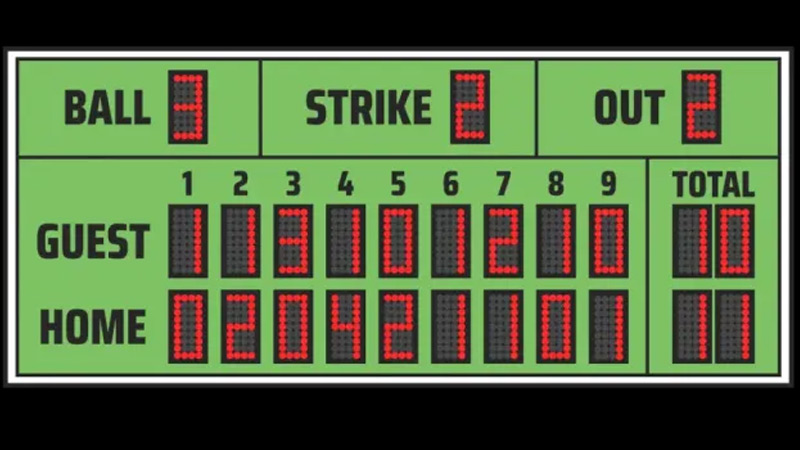Baseball, often called America’s pastime, has its own unique set of terminologies and abbreviations that can confuse newcomers to the sport. One such abbreviation commonly used in baseball is “BOT.”
If you’ve ever heard this term during a game or seen it on a scoreboard, you may be wondering what BOT means in a baseball game.
In this article, we will explore what bot means in baseball and provide you with a comprehensive understanding of this terminology.
What Does BOT Mean in Baseball?
BOT is an abbreviation for “bottom” in baseball. It refers to the second half of an inning, specifically the portion when the home team is at bat. In baseball, each inning consists of two halves: the top and the bottom.
The top half occurs first, where the visiting team gets their chance to bat and try to score runs, while the bottom half follows, allowing the home team to take their turn at the plate.
When you see the term BOT on a scoreboard, it indicates that the game has progressed to the second half of an inning, with the home team about to begin their offensive play.
This is often displayed alongside other abbreviations, such as “TOP” for the top half of an inning and the inning number (e.g., “1” for the first inning, “2” for the second inning, and so on).
Understanding the significance of BOT is crucial for following the flow of a baseball game. Each team takes turns batting and fielding, with the ultimate goal of scoring more runs than their opponent.
The team on defense, or “in the field,” tries to prevent the opposing team from scoring, while the team at bat aims to hit the ball and safely reach the bases to score runs.
Is There A Top and Bottom of Every Inning?
In baseball, each inning consists of two halves: the top half (referred to as “TOP”) and the bottom half (referred to as “BOTTOM” or “BOT”). The visiting team always bats in the top half of the inning, while the home team bats in the bottom half. The order remains the same throughout the game, regardless of how many innings are played.

Source: sportstuffgenius.com
So, to clarify, there is a top and bottom of every inning, with the visiting team batting in the top and the home team batting in the bottom.
In a standard baseball game, there are nine innings, with each inning divided into two halves: the top half and the bottom half. Let’s break it down:
Top Half (TOP)
In the top half of an inning, the visiting team comes to bat. They attempt to score runs by hitting the ball, advancing around the bases, and ultimately crossing home plate. The visiting team’s lineup takes turns batting in a specific order as determined by the manager or coach.
Bottom Half (BOTTOM or BOT)
Once the top half of the inning concludes, the game proceeds to the bottom half. This is when the home team takes their turn at bat. Their objective is the same as the visiting team—to score runs and surpass their opponent’s total. The home team’s lineup also follows a predetermined batting order.
After the bottom half of the inning, the cycle repeats, moving back to the top half of the next inning. This continues until the game reaches the ninth inning or until extra innings are required to determine a winner in the event of a tie.
It’s important to note that during the ninth inning or any subsequent extra innings, if the home team is leading after the top half of the inning, the bottom half may not be played if the home team’s run total is greater than the visiting team’s. In such cases, the game ends without completing the bottom half of the inning.
The distinction between the top and bottom halves of the inning helps keep track of which team is at bat and provides a standardized format for scoring and statistical purposes in baseball.
Does the Home Team Always Hit in the Bottom of the Inning?
No, the home team does not always hit in the bottom of the inning. In the majority of baseball games, the home team does bat in the bottom half of each inning. However, there are some exceptions and scenarios where this order can vary:
Regular Games
In a standard baseball game, the home team bats in the bottom half of each inning, and the visiting team bats in the top half.
Extra Innings
If a game goes into extra innings because the score is tied after the completion of the ninth inning, the order may change. In each subsequent inning, the team that did not bat last in the previous inning (either the top or bottom) will bat first in the new inning.
For example, if the visiting team scores in the top of the tenth inning, the home team will have a chance to bat in the bottom of the tenth inning.
Suspended Games
If a game is suspended due to weather, curfew, or other factors and is resumed at a later time, the inning order will typically pick up where it left off.
If the game was in progress with the visiting team batting in the top half of an inning when it was suspended, it will resume with the visiting team at bat when play resumes.
So, while it is common for the home team to hit in the bottom half of each inning, there are situations where the order can change based on the circumstances of the game.
What is the Bottom of the Ninth Inning?
The “bottom of the ninth inning” is a specific situation in baseball that refers to the final half-inning of a regulation nine-inning game. It occurs when the home team is trailing the visiting team and has their last opportunity to score runs and potentially tie or win the game.
In the bottom of the ninth inning, the visiting team has already batted in the top half of the inning, and the home team takes their turn at bat.
If the home team is trailing, they aim to score enough runs to either tie the game (if they are down by one run) or win the game (if they are down by two or more runs).
The bottom of the ninth inning is often considered a critical and dramatic moment in baseball, as it represents the home team’s final chance to overcome a deficit and secure a victory.
It can be a high-pressure situation for both the batters and the opposing team’s defense, and it often leads to exciting moments and comebacks.
It’s worth noting that if the home team is leading after the top of the ninth inning, they do not need to bat in the bottom half, as they have already secured the win.
However, if the game is tied after the top of the ninth inning, the home team will still bat in the bottom half, providing an opportunity to win the game with a walk-off hit or run.
FAQ
What is the difference between an inning and a half-inning?
An inning refers to the division of a baseball game into two halves, where each team gets a turn to bat and play defense. A half-inning, on the other hand, refers to either the top or bottom portion of an inning when one team is either batting or playing defense.
Are there any other common abbreviations used in baseball?
Yes, baseball has several commonly used abbreviations. Some examples include RBI (Runs Batted In), HR (Home Run), ERA (Earned Run Average), and SO (Strikeout). These abbreviations are often used in scorekeeping, statistics, and game commentary.
What does it mean when a runner is tagged out?
When a runner is tagged out, it means that a defensive player has touched the runner with the ball while the runner was not on base. This results in the runner being declared “out” and removed from the field of play.
What does it mean when a player hits a double, triple, or home run?
These terms describe the different types of hits a batter can achieve. A double occurs when a batter hits the ball and safely reaches second base before the defense can make a play. A triple is similar but refers to reaching third base. A home run is when a batter hits the ball over the outfield fence, allowing them to circle the bases and score a run.
What is a sacrifice bunt or sacrifice fly?
A sacrifice bunt occurs when a batter intentionally hits the ball softly in an attempt to advance a baserunner while sacrificing their own opportunity to get on base. A sacrifice fly, on the other hand, happens when a batter hits a fly ball deep enough to allow a baserunner to tag up and advance to the next base after the catch.
Understanding these frequently asked questions will help you grasp the basics of baseball terminology and enhance your enjoyment of the game.
Final Words
So, now you know what BOT means in baseball? Baseball, like any sport, has its own language, and familiarizing yourself with its unique terminologies is essential to fully enjoy the game.
Now that you know what BOT means in baseball, you can confidently follow the progress of a game, appreciate the strategic moves made by teams, and engage in conversations about America’s favorite pastime.
So, the next time you find yourself watching a baseball game and see the abbreviation BOT displayed on the scoreboard, you can impress your friends and fellow fans with your understanding of the game’s terminology.
Enjoy the excitement of each bottom-half inning as you root for your favorite team to score runs and emerge victorious in the game of baseball.







